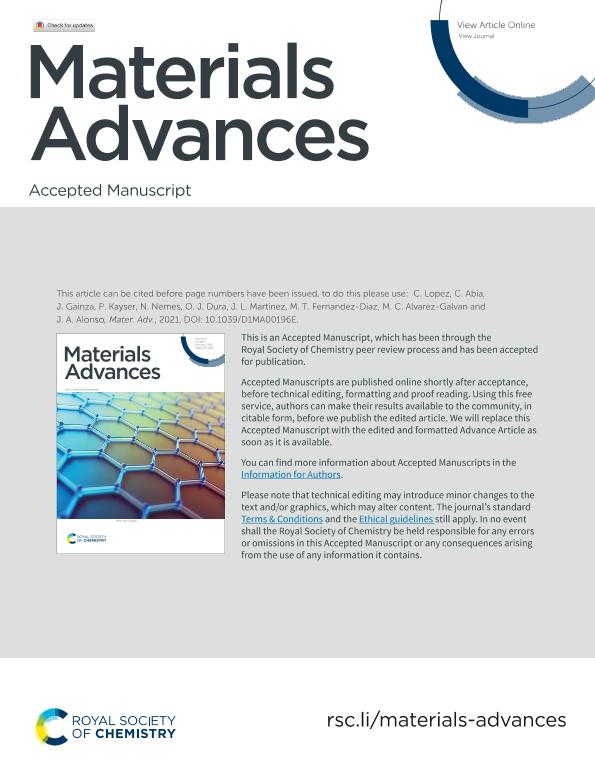Mostrar el registro sencillo del ítem
dc.contributor.author
Lopez, Carlos Alberto

dc.contributor.author
Abia, Carmen
dc.contributor.author
Gainza, Javier
dc.contributor.author
Kayser, Paula
dc.contributor.author
Nemes, Norbert
dc.contributor.author
Dura, Oscar J.
dc.contributor.author
Martinez, Jose L.
dc.contributor.author
Fernandez Diaz, Maria Teresa
dc.contributor.author
Alvarez Galvan, M. Consuelo
dc.contributor.author
Alonso, José Antonio

dc.date.available
2022-10-05T11:55:34Z
dc.date.issued
2021-04
dc.identifier.citation
Lopez, Carlos Alberto; Abia, Carmen; Gainza, Javier; Kayser, Paula; Nemes, Norbert; et al.; Structural evolution, optical gap and thermoelectric properties of CH3NH3SnBr3 hybrid perovskite, prepared by mechanochemistry; Royal Society of Chemistry; Materials Advances; 2; 11; 4-2021; 3620-3628
dc.identifier.issn
2633-5409
dc.identifier.uri
http://hdl.handle.net/11336/171878
dc.description.abstract
Direct bandgap semiconductors of the hybrid-perovskite family CH3NH3PbX3 (X = I, Br, Cl) exhibit outstanding light absorption properties and are the materials of choice for solar energy applications. As an alternative to poisonous Pb, tin-containing perovskites would show a lower effective mass thus exhibiting a higher charge carrier mobility. An auspicious candidate is CH3NH3SnBr3, with an estimated band gap of 1.902 eV, anticipating applications in photovoltaic devices for the visible to ultra-violet wavelength region. We describe that this perovskite can be prepared by ball milling in a straightforward way, yielding specimens with a superior crystallinity. A structural investigation from synchrotron X-ray powder diffraction (SXRD) data was essential to revisit the successive phase transitions this compound experiences down to 120 K, guided by specific heat capacity and DSC measurements. From the cubic structure identified at RT and 270 K, there is a gradual evolution of the patterns, analysed as a phase admixture between the cubic and the low-symmetry phase present at 160 K. This corresponds to an orthorhombic Pmc21 superstructure; this acentric space group enables polarization along the c-axis where there is a twofold screw axis, evidenced in the distribution of Sn-Br distances. Furthermore, there are two conspicuous changes in the orthorhombic framework, yet keeping the Pmc21 space group, which agree with the main calorimetric events (observed at 224 and 147 K). We interpret these changes as an interplay between the tilting of the SnBr6 octahedra of the inorganic framework and the breaking and reconstruction of H-bond interactions with the organic CH3NH+3 unit. The stereochemical effect of the lone electron pair of the Sn2+ ion is clear in the SnBr6 octahedral distortion. Diffuse reflectance UV/Vis spectroscopy yields an optical gap of ∼2.1 eV, in agreement with ab- initio calculations. A Seebeck coefficient of ∼2000 μV K-1 is determined near RT, which is one order of magnitude higher than those reported for other halide perovskites.
dc.format
application/pdf
dc.language.iso
eng
dc.publisher
Royal Society of Chemistry

dc.rights
info:eu-repo/semantics/openAccess
dc.rights.uri
https://creativecommons.org/licenses/by-nc/2.5/ar/
dc.subject
CH3NH3SnBr3
dc.subject.classification
Química Inorgánica y Nuclear

dc.subject.classification
Ciencias Químicas

dc.subject.classification
CIENCIAS NATURALES Y EXACTAS

dc.title
Structural evolution, optical gap and thermoelectric properties of CH3NH3SnBr3 hybrid perovskite, prepared by mechanochemistry
dc.type
info:eu-repo/semantics/article
dc.type
info:ar-repo/semantics/artículo
dc.type
info:eu-repo/semantics/publishedVersion
dc.date.updated
2022-03-08T21:07:32Z
dc.journal.volume
2
dc.journal.number
11
dc.journal.pagination
3620-3628
dc.journal.pais
Reino Unido

dc.journal.ciudad
Londres
dc.description.fil
Fil: Lopez, Carlos Alberto. Consejo Nacional de Investigaciones Científicas y Técnicas. Centro Científico Tecnológico Conicet - San Luis. Instituto de Investigaciones en Tecnología Química. Universidad Nacional de San Luis. Facultad de Química, Bioquímica y Farmacia. Instituto de Investigaciones en Tecnología Química; Argentina. Instituto de Ciencia de Materiales de Madrid; España
dc.description.fil
Fil: Abia, Carmen. Institut Laue Langevin; Francia. Instituto de Ciencia de Materiales de Madrid; España
dc.description.fil
Fil: Gainza, Javier. Instituto de Ciencia de Materiales de Madrid; España
dc.description.fil
Fil: Kayser, Paula. Instituto de Ciencia de Materiales de Madrid; España
dc.description.fil
Fil: Nemes, Norbert. Instituto de Ciencia de Materiales de Madrid; España
dc.description.fil
Fil: Dura, Oscar J.. Universidad de Castilla-La Mancha; España
dc.description.fil
Fil: Martinez, Jose L.. Instituto de Ciencia de Materiales de Madrid; España
dc.description.fil
Fil: Fernandez Diaz, Maria Teresa. Institut Laue Langevin; Francia
dc.description.fil
Fil: Alvarez Galvan, M. Consuelo. Consejo Superior de Investigaciones Científicas; España
dc.description.fil
Fil: Alonso, José Antonio. Instituto de Ciencia de Materiales de Madrid; España
dc.journal.title
Materials Advances
dc.relation.alternativeid
info:eu-repo/semantics/altIdentifier/url/http://pubs.rsc.org/en/Content/ArticleLanding/2021/MA/D1MA00196E
dc.relation.alternativeid
info:eu-repo/semantics/altIdentifier/doi/http://dx.doi.org/10.1039/D1MA00196E
Archivos asociados
